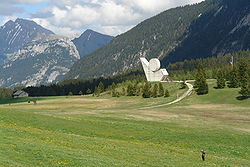- Maquis des Glières
-
The Maquis des Glières was a Free French Resistance group, which fought against the 1940-1944 German occupation of France in World War II. The name is also given to the military conflict that opposed Resistance fighters to German, Vichy and Milice forces.
Battle of Glières Part of Second World War 
Monument commemorating the Maquis des GlièresDate 31 January 1944 – 26 March 1944 Location Plateau des Glières, Massif des Bornes, Haute-Savoie, France Result German and Vichy victory, but propaganda boost for the French Resistance Belligerents  French Resistance
French Resistance Germany
Germany
 Milice
Milice
 Vichy police
Vichy policeCommanders and leaders  Tom Morel †
Tom Morel †
 Maurice Anjot †
Maurice Anjot † Karl Pflaum
Karl Pflaum
 Jean de Vaugelas
Jean de Vaugelas
 Jacques de Bernonville
Jacques de Bernonville
 Georges Lelong
Georges LelongStrength circa 450 maquisards (including 56 spanish fighters and 80 Francs-tireurs) over 1,400 Vichy policemen, 700 Milice Franc-Gardes, 3,000 German soldiers Casualties and losses 140 dead or deported 21 dead Contents
Resistance
At the end of 1943, the French Resistance in the French Alps of Haute-Savoie needed arms. To find good drop zones to supply the Maquis with arms and sabotage equipment, a mission composed of Lieutenant Colonel Heslop from the Special Operations Executive and Captain Rosenthal from the Free French Forces was sent from London. The Glières Plateau, a high remote mountain table close to Lake Annecy, was chosen.
On January 31, 1944, Lieutenant Tom Morel, a Chasseur alpin from the 27th chasseurs alpins battalion (mountain light infantry) in Annecy, was commissioned to collect parachute drops from the Royal Air Force with a hundred men. But Capt. Rosenthal, the Free French representative, convinced the other staff members to regroup the majority of maquisards on the plateau of Glières in order to establish a base to attack the Germans and carry out sabotage. Because the Allies were in doubt about the value of the French Resistance, it was necessary to show its capabilities to undermine the German military power in France.
Repression
In January 1944, a state of siege was declared in Haute-Savoie. Anyone found carrying arms or assisting the Maquis was subject to immediate court martial and execution. Hunted by the Vichy police and badly supplied, most of the maquisards gathered on the plateau of Glières to set up the base of operations. Soon after, a hundred French communist resistants and about fifty Spanish lumberjacks joined forces with them in taking refuge and getting weapons. From February 13 on, the four hundred and fifty maquisards, under the command of officers from the 27th chasseurs alpins battalion, were besieged by two thousand French militiamen and police. Although they suffered from starvation and freezing conditions, they collected three parachute drops consisting of about three hundred containers packed with explosives and small arms (Sten submachine guns, Lee-Enfield rifles, Bren light machine guns, Mills bomb grenades).
On the night of the 9th and 10th of March, the commander-in-chief, Lt. Tom Morel, was killed in a skirmish with the Vichy forces.
On March 12th, after the largest Allied parachute drop, the Germans started to bomb the area with ground attack aircraft. The French Militia staged several attacks, but they ended in failure. On March 23rd, three battalions from the 157th Reserve Division of Wehrmacht and two German police battalions, composed of more than four thousand, with heavy machine guns, 80 mm mortars, 75 mm mountain guns, 150 mm howitzers and armoured cars, concentrated in Haute-Savoie.
Retreat
Word had seeped out of France to Britain and America that a great and glorious uprising had taken place in southeast France. Clearly, Glières had become an important element in the psychological warfare. To honour the French Resistance, the new leader, Capt. Anjot, an experienced, thoughtful and impassive officer, would fight in the face of defeat, but his aim was to save his men's lives.
Finally, on March 26 1944, after another air raid and shelling, the Germans took the offensive. They split their attacking parties into three groups (Kampfgruppen) and designated to each a specific target. Reconnaissance was carried out by ski patrols dressed in white camouflage. One of the patrols with a Gebirgsjäger (mountain troops) platoon made an attack on the main exit to the plateau and captured an advanced post in the rear. Sustaining the attack from about fifty German soldiers, eighteen maquisards fought and resisted into the night, but were outnumbered and overwhelmed, though most of them succeeded in escaping under cover of darkness. At ten o'clock, Capt. Anjot decided honour had been satisfied and ordered the Glières battalion to retreat. In the days that followed, he and almost all his officers as well as one hundred and twenty maquisards were found dead. They had been killed in battle or, if taken prisoner, had been tortured, shot or deported. For the Germans, the maquisards were not regulars but terrorists.
The region of Savoie had been absolutely shattered. But this defeat would be transformed into a moral victory and give a boost to the French Resistance in the spring of 1944. After the American and French landing in Provence on the 15th of August 1944, it is a mark of the Maquis' success in the French Alps that the speed of the American advance and the rapid retreat of the Germans was far beyond the expectations of Allied planning staff.
See also
- Maquis du Vercors
- Maquis du Mont Mouchet
- French Resistance
- Free French Forces
- French Forces of the Interior
- Liberation of Paris
References
External links
Categories:- French Resistance
- Battles of World War II involving France
- Battles of World War II involving Germany
- Military battles of Vichy France
- Uprisings during World War II
- Guerrilla warfare
- Military history of France during World War II
Wikimedia Foundation. 2010.
